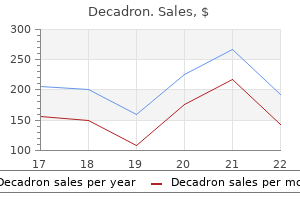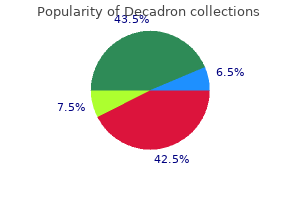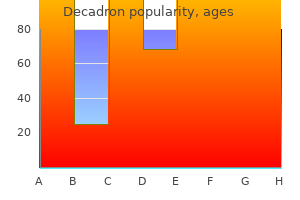Berk Burgu, MD, FEAPU
- Clinical Instructor,
- Ankara University School of Medicine,
- Department of Urology, Division of Pediatric Urology,
- Ankara, Turkey
Evaluation and manage induced hypoglycemia in type 1 diabetes using from parents and other adults to the ment of youth-onset type 2 diabetes: a position real-time continuous glucose monitoring and a care skin care for rosacea buy decadron 0.5mg low price. Revised: additional benet of disease-specic Prolonged exercise in type 1 diabetes: perfor Screening and support for emotional burdens screening in adolescents with type 1 diabetes skin care chanel purchase discount decadron on-line. Psychometric tes-related quality of life among youth with creased carbohydrate supply is implemented properties of the Problem Areas in Diabetes: type 1 diabetes skin care md effective 0.5 mg decadron. Psychosocialcare tensied insulin treatment: a nationwide pop on intermittent sports performance acne while pregnant cheap decadron 4mg amex. Family-basedpsychoeducationand Contrasting the clinical care and outcomes of have poor prognostic factors. A population-based study of risk factors for tion statement of the American Diabetes Asso 42. J ing tool for disordered eating in diabetes: internal management system in-clinic. Diabetes distress among adolescents clinical signicance and treatment recommen 61. Factorsassociatedwithdiabetes-specic diabeteseatingproblemsurveyinTurkishchildren Safety of a hybrid closed-loop insulin delivery health-related qualityoflifeinyouthwith and adolescents with type 1 diabetes mellitus. Screening for coeliac disease dren and adolescents with type 1 diabetes: monitoring of blood glucose and hemoglobin in type 1 diabetes. Screening for celiac abetes: cross-sectional data from the German multicenter data from Germany and Austria. Prevalence of celiac disease in 52, 721 artery tonometry demonstrates altered endo 69. Nimri R, Weintrob N, Benzaquen H, Ofan R, youth with type 1 diabetes: international com thelial function in children with type 1 diabetes. Expert Panel on Integrated Guidelines for multiple daily injections using insulin glargine. AbidN, McGloneO, CardwellC, McCallionW, American Heart Association Expert Panel on abetes from the T1D Exchange Clinic Registry. Hepatology, and Nutrition guidelines for the Heart Association Council on the Kidney in Heart Additional autoimmune disease found in 33% of diagnosis of coeliac disease. J Pediatr Gastro Disease; Interdisciplinary Working Group on patients at type 1 diabetes onset. Kordonouri O, Deiss D, Danne T, Dorow A, of a gluten-free diet for asymptomatic patients patients: a scientic statement from the Amer Bassir C, Gruters-Kieslich A. Microvas ofdiabetesinyouth:lessonslearnedfromstudies rosis, Hypertension, and Obesity in Youth Com cular complications assessment in adolescents of type 2 diabetes. Kapadia C, Zeitler P; Drugs and Therapeu Heart Association Council on Cardiovascular 689 tics Committee of the Pediatric Endocrine Soci Nursing. Hemoglobin A1c measurement for the malities in children and adolescents: a scientic alence of and risk factors for diabetic peripheral diagnosis of type 2 diabetes in children. Depression, antidepressants, of a diabetes education program for youth with Longitudinal Assessment of Bariatric Surgery and weight gain in children.

Complete a primary survey before moving the mother from the trauma bay for any reason acne home treatments buy discount decadron on line. Maintain airway the supraglottic airway is extremely susceptible to obstruction from edema as a result of exposure to superheated air acne 5 days before period cheap decadron 0.5mg with visa. Assess for clinical signs of inhalation injury: Facial burns/singeing of the eyebrows and nasal hairs Carbonaceous sputum and acute inflammatory changes in the oropharynx skin care quotes purchase decadron 4 mg on-line, raspy voice History of impaired mentation and/or confinement in a burning environment Assess for toxic inhalation acne under arms buy cheap decadron on-line, or carbon monoxide poisoning B. Half should be given in first 8 hours from time of burn and second half over next 16 hours) for administration of fluid. History time and mechanism of the injury; enclosed fire, or if toxic chemicals involved C. Second degree: (Superficial Partial Thickness or Deep partial thickness): characterized by a red or mottled appearance with swelling and blister formation. Third degree: (full thickness): skin appears dark and leathery; may also appear translucent, mottled, or waxy white; the surface is painless and generally dry, but may also be moist D. Check pulses with a Doppler (absent pulse may indicate inadequate fluid resuscitation) d. Observe for cyanosis, impaired capillary refill, or progressive neurological signs. Limb Escharotomy Relieve compromised distal circulation in a circumferentially burned limb by escharotomy, which can be done without anesthesia, due to the insensitive full thickness burn 1. The incision must extend across the entire length of the eschar in the lateral and/or medial line of the limb including the fingers and joints 2. The incision should be deep enough to allow the cut edges of the eschar to separate F. Thoracic Escharotomy: Circumferential burns of the thorax occasionally impair respiratory excursion. Bilateral, mid-axillary escharotomy incisions should be considered Special Burn Requirements A. Flush burns for at least 20 to 30 minutes; alkali burns require longer irrigation 2. Alkali burns to the eye require continuous irrigation during the first eight hours B. The force of a flash flame explosion is enough energy to cause concussive type of injuries. Furthermore, it has been reported that the head injured patients on warfarin have an increased risk of mortality from 2-fold to 4-fold, when compared with non-anti-coagulated patients with ii similar degrees of head injury. As part of the trauma workup, one should always obtain an adequate history, which includes a list of current home medication. Early identification of warfarin use has been shown to reduce iii mortality on patients with intracranial hemorrhage from 48% to 9%. In the same study, mean time to warfarin reversal (normal coagulation profile) was 1. Another important aspect of the anti-coagulated patient is the decreased reliability of their neurological exam. Indeed, one study reported two anti coagulated patients with no loss of consciousness that eventually died from consequence of 2 intracranial hemorrhage. Preinjury warfarin use among elderly patients with closed head injuries in a trauma center. Rapid warfarin reversal in anticoagulated trauma patients with intracranial hemorrhage reduces hemorrhage progression and mortality. Discontinuing ventilator support should be done at the earliest possible time after the disease process has been adequately reversed. Rather, patients should be assessed for eligibility for separation from the ventilator and if appropriate, separated. There are no dogmatic rules or hard and fast guidelines regarding the timing or duration of the process. Adequate pain control [remember to decrease and/or withdrawal pain/sedation medications to level of adequate pain control without over sedation]. Encourage incentive spirometry, deep breathing and coughing per unit guidelines Post Extubation Therapy: Breathing Exercises: the most effective method of preventing post-extubation pulmonary complications is to encourage maximal voluntary deep breathing and coughing. Aerosol Therapy: Stridor Upper airway stridor is best treated with nebulized racemic epinephrine Bronchoconstriction Bronchodilators delivered via nebulized aerosol effectively reverse airway constriction. Specific drugs have varying B1 and B2 effects that will influence the choice of a particular medication. Patients that do not exhibit clinical evidence of bronchoconstriction will not benefit from this therapy. Secretions: Thick, tenacious, inspissated secretions can be effectively treated with heated aerosol. Some patients may require the addition of a mucolytic agent [Mucomyst] delivered per hand held nebulizer. A mucolytic agent is an irritant that can cause bronchospasm and should be discontinued after 48 hours due to bronchorrhea. Percussion and Postural Drainage: the indication for therapy is very narrow and specific. In order to achieve maximum benefit, the patient must be able to cooperate with the respiratory therapist. A large number of contraindications to this form of therapy, some of which are listed, limit its use in the critically ill patient. Mechanical Ventilation: Division of th Surgery, Division of Trauma/Critical Care and the Department of Respiratory Therapy, 4 Ed, 2008. Using aseptic technique (mask, gloves, cap), advance the catheter out of the protective sheath at the opened end and gently insert protected catheter through the endotracheal tube or tracheostomy cannula into the pulmonary tract until resistance is felt. Pull the set back 3-4 cm, remove the plastic spacer, and advance inner catheter to fully expel the distal polyethylene glycol plug. Prevention of nosocomial pneumonia in intubated patients in respective role of mechanical subglottic secretion drainage and stress ulcer prophylaxis. Supine body position as a risk factor for nosocomial pneumonia in mechanically ventilated patients: a randomized trial. Daily interruption of sedative infusions in critically ill patients undergoing mechanical ventilation. The effect of a comprehensive oral care protocol on patients at risk for ventilator-associated pneumonia. Reviewed: 03/05 111 112 113 Reviewed 10/08 University of Kentucky Medical Center Trauma Intensive Care Unit Analgesic and Sedation Protocol Introduction: Injuries, surgical wounds, and the attendant critical illness are associated with moderate to severe pain, as well as anxiety and agitation. Intense sympathetic and parasympathetic responses can and do occur with pain and anxiety. When pain and anxiety are not promptly and adequately relieved, excessive adrenergic activity and hormonal changes indicative of stress occur. These physiologic stress reactions produce a marked increase in metabolism, cardiac workload, and oxygen consumption that may compromise tissue oxygenation in the critically ill patient. The goal is to provide effective, sustained pain relief and sedation with minimal side effects. Analgesia: Morphine is the analgesic drug of choice and may be used alone or in conjunction with a sedative. Continuous intravenous infusion of morphine is preferable because it avoids peaks and troughs in blood levels leading to over and under sedation. When pain control cannot be achieved with morphine, fentanyl is an effective, inexpensive alternative. Frequently, escalating doses are required to reach therapeutic levels and clinical effect. Anxiety: Benzodiazepines are the principle class of drugs for treatment of anxiety. Benzodiazepines should also be used to insure deep sedation for patients requiring neuromuscular blocking agents. Benzodiazepines may be used for patients who do not respond to haloperidol or for those patients in whom haloperidol is contraindicated.

Continuing haemodynamic instability unresponsive to aggressive resuscitation due to renal haemorrhage is an indication for exploration acne yeast purchase online decadron, irrespective of the mode of injury [72 skin care uk discount decadron 1 mg online, 86] acne 8o buy discount decadron 8mg on line. Other indications include an expanding or pulsatile peri-renal haematoma identified at exploratory laparotomy performed for associated injuries acne 6 months after accutane purchase decadron on line. Persistent extravasation or urinoma are usually managed successfully with endourological techniques. Inconclusive imaging and a pre-existing abnormality or an incidentally diagnosed tumour may require surgery even after minor renal injury [42]. Grade 5 vascular injuries are regarded as an absolute indication for exploration, but parenchymal grade 5 patients who are stable at presentation may be safely treated conservatively [87-90]. In these patients, intervention is predicted by the need for continued fluid and blood resuscitation, peri-renal haematoma size > 3. The goal of exploration following renal trauma are control of haemorrhage and renal salvage. Access to the pedicle is obtained either through the posterior parietal peritoneum, which is incised over the aorta, just medial to the inferior mesenteric vein or by bluntly dissecting along the plane of the psoas muscle fascia, adjacent to the great vessels, and directly placing a vascular clamp on the hilum [94]. Stable haematomas detected during exploration for associated injuries should not be opened. Central or expanding haematomas indicate injuries of the renal pedicle, aorta, or vena cava and are potentially life-threatening [95]. In cases with unilateral arterial intimal disruption, repair can be delayed, especially in the presence of a normal contralateral kidney. However, prolonged warm ischaemia usually results in irreparable damage and renal loss. Entering the retroperitoneum and leaving the confined haematoma undisturbed within the perinephric fascia is recommended unless it is violated and cortical bleeding is noted; packing the fossa tightly with laparotomy pads temporarily can salvage the kidney [96]. Haemorrhage can occur while the patient is resuscitated, warmed, and awaits re-exploration, however, careful monitoring is sufficient. A brief period of controlled local urinary extravasation is unlikely to result in a significant adverse event or impact overall recovery. Ureteral stenting or nephrostomy diversion should be considered after delayed reconstruction due to the increased risk of postoperative urinary extravasation. The overall rate of patients who undergo a nephrectomy during exploration is around 13%, usually in patients with penetrating injuries and higher rates of transfusion requirements, haemodynamic instability, and higher injury severity scores [98]. Other intra abdominal injuries also slightly increase the need for nephrectomy [99]. Mortality is associated with overall severity of the injury and not often a consequence of the renal injury itself [100]. In gunshot injuries caused by a high-velocity bullet, reconstruction can be difficult and nephrectomy is often required [101]. Watertight closure of the collecting system, if open, is desirable, although closing the parenchyma over the injured collecting system also has good results. If the capsule is not preserved, an omental pedicle flap or peri renal fat bolster may be used for coverage [102]. Following blunt trauma, repair of vascular injuries (grade 5) is seldom, if ever, effective [104]. Repair should be attempted in patients with a solitary kidney or bilateral injuries [105], but is not used in the presence of a functioning contralateral kidney [26]. Nephrectomy for main artery injury has outcomes similar to those of vascular repair and does not worsen post-treatment renal function in the short-term. Isolated grade 1-3 stab and low-velocity gunshot wounds in stable patients, after complete staging, B should be managed expectantly. Radiological embolisation is indicated in patients with active bleeding from renal injury, but without B other indications for immediate abdominal operation. Intraoperatively, renal reconstruction should be attempted once haemorrhage is controlled and there is B sufficient viable renal parenchyma. Repeat imaging 2-4 days after trauma minimises the risk of missed complications, especially in grade 3-5 blunt injuries [106]. Repeat imaging can be safely omitted for patients with grade 1-4 injuries as long as they remain clinically well [107]. Nuclear scans are useful for documenting and tracking functional recovery following renal reconstruction [108]. Follow-up should involve physical examination, urinalysis, individualised radiological investigation, serial blood pressure measurement and serum determination of renal function [68]. A decline in renal function correlates directly with injury grade; this is independent of the mechanism of injury and the method of management [109, 110]. Follow-up examinations should continue until healing is documented and laboratory findings have stabilised, although checking for latent renovascular hypertension may need to continue for years [111]. In general, the literature is inadequate on the subject of the long-term consequences of renal tissue trauma. Delayed complications include bleeding, hydronephrosis, calculus formation, chronic pyelonephritis, hypertension, arteriovenous fistula, hydronephrosis and pseudo-aneurysms. Delayed retroperitoneal bleeding may be life-threatening and selective angiographic embolisation is the preferred treatment [112]. Perinephric abscess formation is best managed by percutaneous drainage, although open drainage may sometimes be required. Percutaneous management of complications may pose less risk of renal loss than re-operation, when infected tissues make reconstruction difficult [86]. Renal trauma is a rare cause of hypertension, and is mostly observed in young men. The frequency of posttraumatic hypertension is estimated to be less than 5% [113, 114]. Hypertension may occur acutely as a result of external compression from peri-renal haematoma (Page kidney), or chronically due to compressive scar formation. Treatment is required if the hypertension persists and could include medical management, excision of the ischaemic parenchymal segment, vascular reconstruction, or total nephrectomy [115]. Urinary extravasation after reconstruction often subsides without intervention as long as ureteral obstruction and infection are not present. Persistent urinary extravasation from an otherwise viable kidney after blunt trauma often responds to stent placement and/or percutaneous drainage as necessary [117]. Arteriovenous fistulae usually present with delayed onset of significant haematuria, most often after penetrating trauma. Post-procedural complications include infection, sepsis, urinary fistula, and renal infarction [119]. In numerous case reports, transcatheter embolisation appears to be a reliable minimally invasive solution [120]. Acute renal colic from a retained missile has been reported, and can be managed endoscopically if possible [121]. C First follow-up should be approximately 3 months after major renal injury with hospitalisation. Each C follow-up should include: physical examination, urinalysis, individualised radiological investigation, serial blood pressure measurement and renal function tests. Medical management and minimally invasive techniques should be the first choice for the C management of complications. The incidence of associated injury in penetrating renal trauma ranges from 77% to 100%. Gunshot wounds are associated with adjacent organ injury more often than stab wounds. Most patients with penetrating renal trauma have associated adjacent organ injuries that may complicate treatment. In the absence of an expanding haematoma with haemodynamic instability, associated multiorgan injuries do not increase the risk of nephrectomy [29]. Blunt and penetrating injuries contribute equally to combined renal and pancreatic injury. Renal preservation is achieved in most patients, and the complication rate is 15% [122]. A similar rate of complications (16%) is reported in patients with simultaneous colon and renal injury [123]. In cases where surgical intervention is chosen, all associated abdominal injuries should be managed C where appropriate simultaneously. When deciding on conservative management all injuries should be considered independently.
Order decadron. Skin Care Laser Clinic in Patna Bihar Best Dermatologist and Cosmetologist in Patna.


